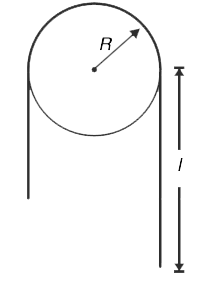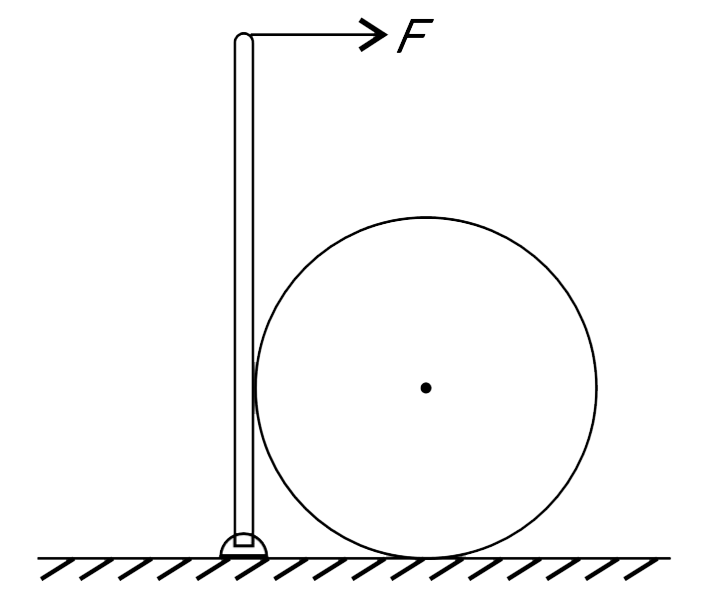A rocket has been fired upwards to launch a satellite in its orbit. Name the two forces acting on the rocket immediately after leaving the launching pad ( Ignore the frictional force due to air resistance )
The two forces acting on the rocket are the force of gravity, which pulls the rocket towards the ground, and the force of friction due to earth.s atmosphere, which opposes its motion.
Topper's Solved these Questions
- FORCE AND PRESSURE BOOK - NCERTCHAPTER - FORCE AND PRESSURE EXERCISE - EXERCISE (Fill in the blanks in the statement)
4 Videos
- CHEMICAL EFFECTS OF ELECTRIC CURRENT BOOK - NCERTCHAPTER - CHEMICAL EFFECTS OF ELECTRIC CURRENT EXERCISE - QUESTIONS
16 Videos
- FRICTION BOOK - NCERTCHAPTER - FRICTION EXERCISE - EXERCISE
9 Videos
Similar Questions
A rocket has been fired upwards to launch a satellite in its orbit. Name the two forces acting on the rocket immediately after leaving the launching pad.
View SolutionA rope of length L and mass per unit length λ passes over a disc shaped pulley of mass M and radius R. The rope hangs on both sides of the pulley and the length of larger hanging part is l. The pulley can rotate about a horizontal axis passing through its centre. The system is released from rest and it begins to move. The pulley has no friction at its axle and the rope has large enough friction to prevent it from slipping on the pulley.
(a) Find the acceleration of the rope immediately after it is released.
(b) Find the horizontal component of the force applied by the axle on the pulley immediately after the system is released

View Solution
Knowledge Check
Once a satellite has been launched into orbit, the only force governing its motion is the force of ______ .
AgravityBelasticityCfrictionDfuel drivenOnce a satellite has been launched into orbit, the only force governing its motion is the force of ______ .
AA) gravityBB) elasticityCC) frictionDD) fuel drivenThe satellites when launched from the earth are not given the orbital velocity initially, a multistage rocket propeller carries the spacecraft up to its orbit and during each stage rocket has been fired to increase the velocity to acquire the desired velocity for a particular orbit. The last stage of the rocket brings the satellite in circular/elliptical (desired) orbit.
Consider a satellite of mass 150kg in a low circular orbit. In this orbit, we cannot neglect the effect of air drag. This air opposes the motion of satellite and hence the total mechanical energy of earth-satellite system decreases. That means the total energy becomes more negative and hence the orbital radius decreases which causes the increase in KE When the satellite comes in the low enough orbit, excessive thermal energy generation due to air friction may cause the satellite to burn up. Based on the above information, answer the following questions.
If due to air drag, the orbital radius of the earth decreases from R to R−△R,△R<<R, then the expression for increase in the orbital velocity △v isA△r2√GMR3B−△R2√GM2C△R√GMR3D−△R√GMR3
A satellite is orbiting around the earth in a circular orbit and in this orbit magnitude of its acceleration is a1 . Now a rocket is fired in the direction of motion of satellite from the satellite due to which its speed instantaneously becomes half of initial, just after the rocket is fired acceleration of satellite has magnitude a2 . Then the ratio a1a2 is (Assume there is no external force other than the gravitational force of earth before and after the firing of rocket from the satellite)
View SolutionA planet of mass M, has two natural satellites with masses m1 and m2. The radii of their circular orbits are R1 and R2 respectively. Ignore the gravitational force between the satellites. Define v1,L1,K1 and T1 to be, respectively, the orbital speed, angular momentum, kinetic energy and time period of revolution of satellite 1 , and v2,L2,K2 and T2 to be he corresponding quantities of satellite 2. Given m1/m2=2 and R1/R2=1/4, match the ratios in List-I to the numbers in List-II.

View SolutionA uniform rod of mass M and length L is hinged at its lower end on a table. The rod can rotate freely in vertical plane and there is no friction at the hinge. A ball of mass M and radius R=L3 is placed in contact with the vertical rod and a horizontal force F is applied at the upper end of the rod.
(a) Find the acceleration of the ball immediately after the force starts acting.

(b) Find the horizontal component of hinge force acting on the rod immediately after force F starts acting.
View SolutionA planet of mass , has two natural satellites with masses and . The radii of their circular orbits are and respectively. Ignore the gravitational force between the satellites. Define , and to be, respectively, the orbital speed, angular momentum, kinetic energy and time period of revolution of satellite 1, and , , and to be the corresponding quantities of satellite 2. Given/2and/1/4, match the ratios in List-I to the numbers in List-II.

View SolutionThe satellites when launched from the earth are not given the orbital velocity initially, a multistage rocket propeller carries the spacecraft up to its orbit and during each stage rocket has been fired to increase the velocity to acquire the desired velocity for a particular orbit. The last stage of the rocket brings the satellite in circular/elliptical (desired) orbit.
Consider a satellite of mass 150kg in a low circular orbit. In this orbit, we cannot neglect the effect of air drag. This air opposes the motion of satellite and hence the total mechanical energy of earth-satellite system decreases. That means the total energy becomes more negative and hence the orbital radius decreases which causes the increase in KE When the satellite comes in the low enough orbit, excessive thermal energy generation due to air friction may cause the satellite to burn up. Based on the above information, answer the following questions.
It has been mentioned in the passage that as r decreases, E decreases but K increases. The increase in K is [E= total mechanical energy, r= orbital radius, K= kinetic energy ]
View Solution